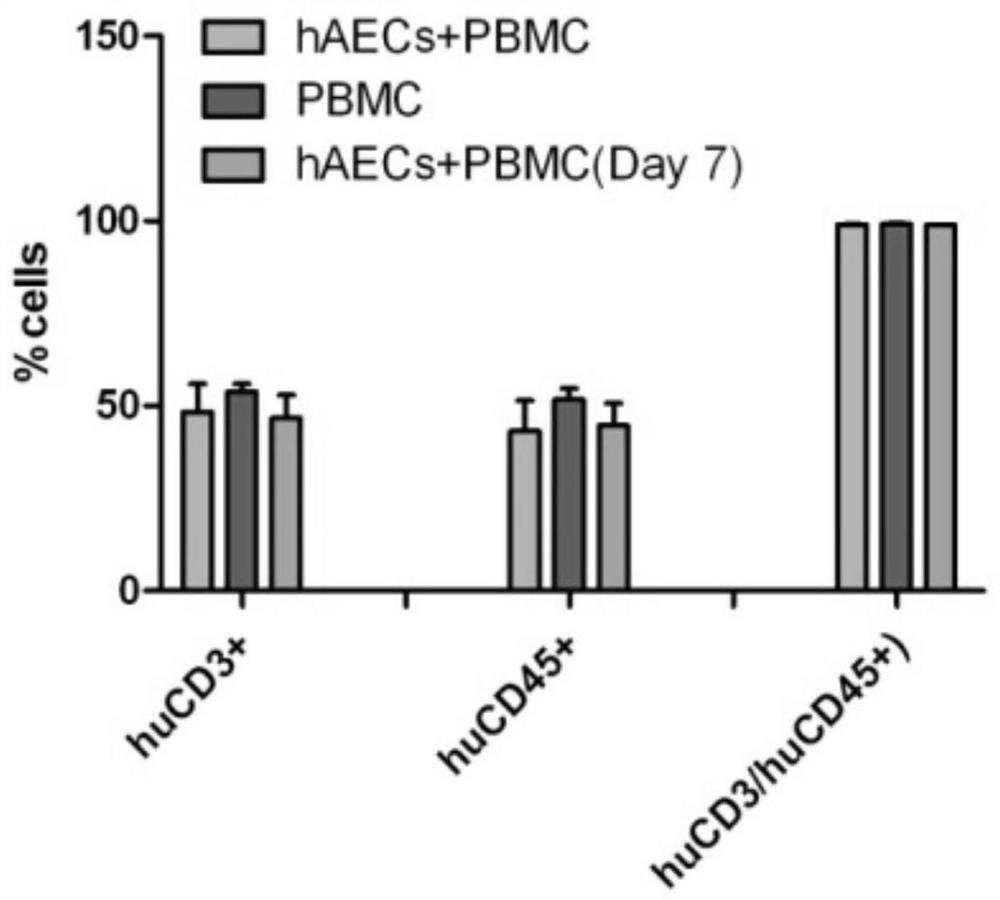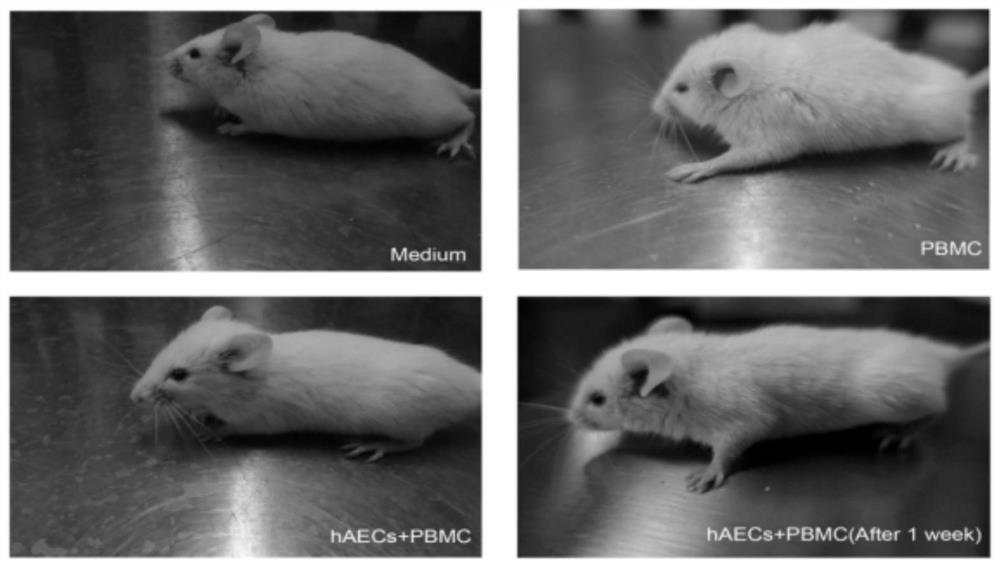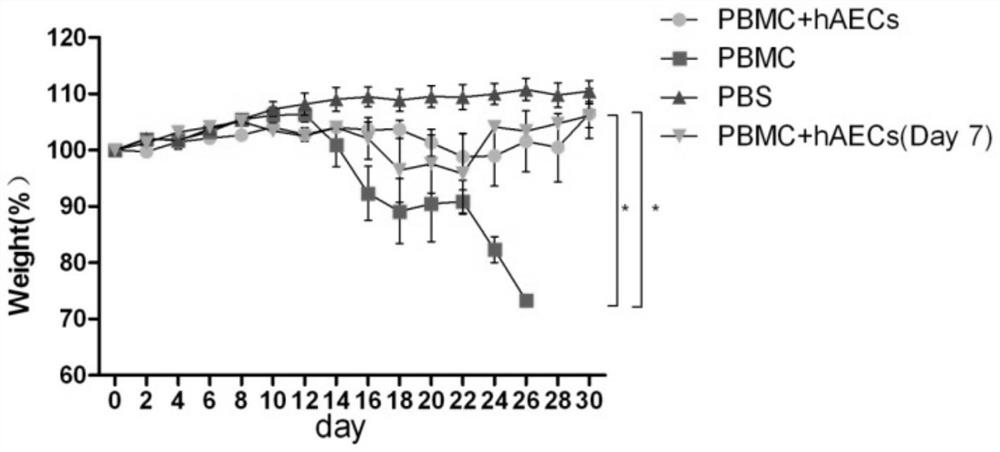Use of human amniotic epithelial cells in the treatment of graft-versus-host disease
A technique of graft-versus-host and amnion epithelial cells, which is applied in the biological field to achieve the effect of reducing infiltration, reducing target organ lesions, and good results
- Summary
- Abstract
- Description
- Claims
- Application Information
AI Technical Summary
Problems solved by technology
Method used
Image
Examples
Embodiment 1
[0057] Example 1 Isolation and culture of primary amniotic membrane epithelial cells
[0058] 1. The source of human amniotic membrane
[0059] In order to avoid microbial contamination of the birth canal, fetal placenta was selected by caesarean section. Due to the stimulation of labor signals after term, the amniotic membrane will undergo apoptosis, so it is advisable to use premature fetal placenta (before 38 weeks). After the mother’s authorization and consent, the placental tissue of the healthy mother (HIV, syphilis, hepatitis A, hepatitis B, hepatitis C and other serological reactions were all negative) after cesarean section was taken, the placenta was cut with a cross knife, and the whole amniotic membrane was obtained by mechanical separation.
[0060] 2. Isolation of hAECs (aseptic operation is required throughout the process)
[0061] Obtain the placenta of infants born by caesarean section before 39 weeks, remove the amniotic membrane from the inner surface of t...
Embodiment 2
[0073] Example 2 Separation, cultivation and cryopreservation of human peripheral blood mononuclear cells
[0074] Aseptically draw the donor's peripheral blood into a collection strip containing anticoagulant.
[0075] Add 5ml of Ficoll solution to a 50ml centrifuge tube, draw blood with a sterile Pasteur pipette and gently drop on the Ficoll solution.
[0076] Without centrifugal acceleration, centrifuge at 400g for 30min at room temperature until the blood is clearly stratified.
[0077] Carefully absorb the buffy coat layer in the stratification with a new Pasteur pipette, add it to 10ml of DPBS (containing 1xPS) and mix well. Centrifuge at 300g for 5min at room temperature and discard the liquid.
[0078] Resuspend the pellet in 10ml of DPBS (containing 1xPS), centrifuge at 300g for 5min at room temperature, and discard the liquid.
[0079] Resuspend in complete medium (1640, 10% FBS, PS) for later use, or resuspend in freezing solution and freeze in liquid nitrogen. ...
Embodiment 3
[0080] Example 3 Mouse Model Establishment and Scoring Criteria for aGVHD Mouse
[0081] 1. Establishment of irradiation injury model in NOD / SCID mice
[0082] NOD / SCID mice purchased from the company at the age of 6-8 weeks were transferred to the animal room for 1 week to adapt to the environment. Add gentamicin (32x10^4U / L) and erythromycin (250mg / L) to drinking water.
[0083] One week later, the mice were sublethally irradiated with 2.7 Gray dose of X-rays.
[0084] The next day, 2×10^6 hAECs were injected into each mouse via the tail vein. The control group was injected with corresponding volume of PBS.
[0085] 2. Establishment of acute GVHD model in NCG mice
[0086] NCG mice aged 6-8 weeks were purchased from the company and transferred to the animal room for 1 week to adapt to the environment. Add gentamicin (32x10^4U / L) and erythromycin (250mg / L) to drinking water.
[0087] One week later, each mouse was injected with 10^7 human peripheral blood mononuclear ce...
PUM
 Login to View More
Login to View More Abstract
Description
Claims
Application Information
 Login to View More
Login to View More - R&D
- Intellectual Property
- Life Sciences
- Materials
- Tech Scout
- Unparalleled Data Quality
- Higher Quality Content
- 60% Fewer Hallucinations
Browse by: Latest US Patents, China's latest patents, Technical Efficacy Thesaurus, Application Domain, Technology Topic, Popular Technical Reports.
© 2025 PatSnap. All rights reserved.Legal|Privacy policy|Modern Slavery Act Transparency Statement|Sitemap|About US| Contact US: help@patsnap.com



